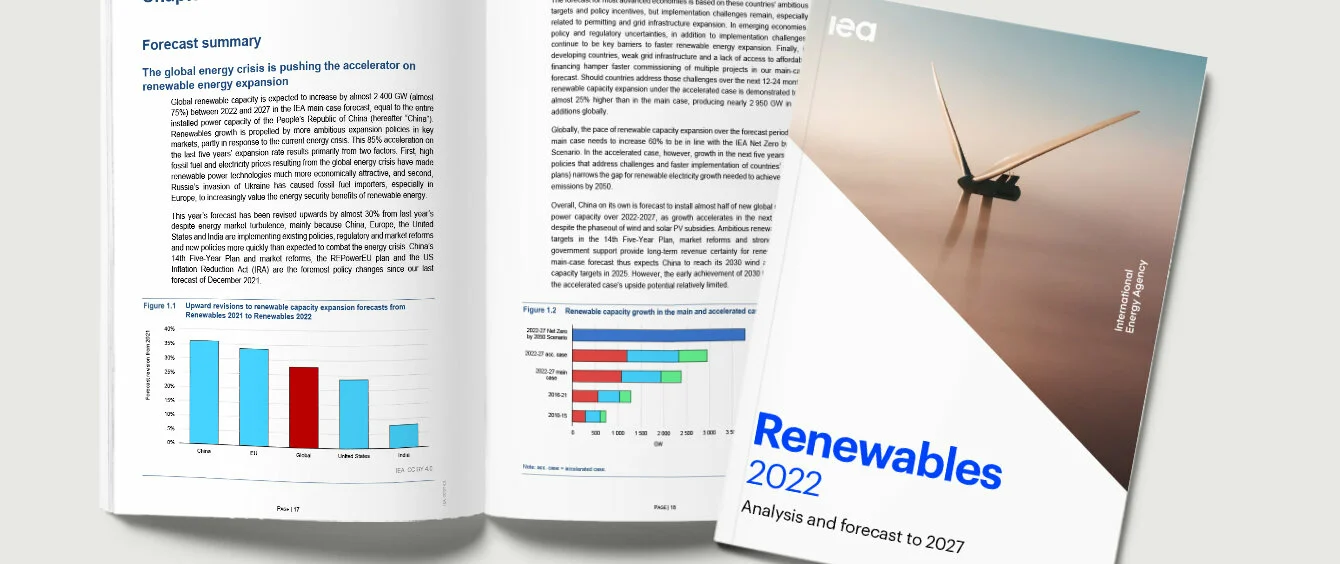“Renewables were already expanding quickly, but the global energy crisis has kicked them into an extraordinary new phase of even faster growth as countries seek to capitalise on their energy security benefits. The world is set to add as much renewable power in the next five years as it did in the previous 20 years,” explained IEA Executive Director Fatih Birol on publication of the Renewables 2022 analysis in December. He emphasised that this constituted a clear example of how the current energy crisis could be a historic turning point towards a cleaner and more secure energy system.
According to the IEA’s forecast, renewable energy generation is expected to reach new heights in the coming years, as it is increased at a hitherto unseen pace – becoming the most important energy source in global power production. This rapid growth will be largely attributable to solar and wind energy. The en:former has summarised the key figures and forecasts of the Renewables 2022 analysis.
Renewables set to grow by 2,400 GW
According to the IEA, renewable capacity is set to rise by 2,400 GW, which almost equals the entire currently installed power capacity of China, the most populous country in the world. This would mean that renewables would grow faster in the next five years than they did in the last 20. The past decade has already been shaped by commercial breakthroughs and strong growth in the solar and wind sector – a trend that is only set to continue.
Largely thanks to this boom, renewables will account for more than 90 percent of global electricity generation capacity additions during this period. Renewables will see the biggest growth in China, the EU, the USA and India. The IEA also identified the REPowerEU Plan and the Inflation Reduction Act in the US as key drivers of this accelerated growth.
The largest source of electricity in the global power mix
Renewable energy (water, wind, solar and biomass combined) is expected to become the main source of global electricity generation, most likely overtaking coal by 2025. Its share of the power mix will likely rise from 28 percent (2021) to 38 percent (2027), with 20 percent of this change being attributable to solar and wind power. In contrast, the importance of fossil fuels will probably decline.
Solar and wind – both volatile energy sources – are to record the strongest growth in the years ahead. Integrating them into the power system calls for flexible solutions such as batteries. The expansion of base load power from green sources such as hydrogen and geothermal energy will be limited.
Solar and wind boast strongest growth
The installed capacity of photovoltaic systems is forecast to rise by almost 1,500 GW over the next five years, exceeding all other energy sources, namely natural gas by 2026 and coal by 2027. Annual solar PV capacity additions are set to increase annually – meaning every year will set a new record. Despite recent rises in commodity prices, solar systems are generally the cheapest way of producing electricity in many countries.
Share of cumulative power capacity by technology, 2010-2027
in per cent, source: IEAPredictions also have wind energy registering a boom in the coming year, albeit not to the same extent as electricity generation from solar systems. Onshore wind farms with a total capacity of 570 GW are due to go online, although the sector will have to wait until 2027 to break the annual record set in 2020. Over the short and medium term, lengthy approval procedures and a lack of improvements to grid infrastructure will hinder rapid expansion. Offshore wind generation will also see strong growth, particularly in North America, Asia and Europe.
50 GW of wind and PV capacity focused on producing hydrogen
The renewables analysis also takes a look at the future of green hydrogen by examining the policies and targets introduced in more than 25 countries across all continents. According to this research, around 50 GW of wind and PV capacity used to produce green hydrogen could be built by 2027. The IEA has identified China, Australia, Chile and the USA as leaders in this field.
